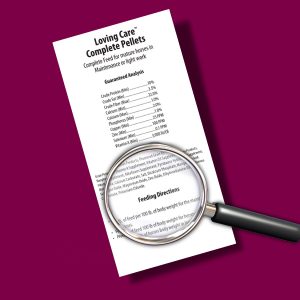
It’s on the Horse Feed Tag – Part 7
Feeding directions are a good place to start.
It is very important to understand that feeds are formulated by nutritionists to be fed at specific rates. When the correct amount of feed is provided, the horse consumes the appropriate amount of energy and nutrients. The feeding directions included on the feed tag are specific to a particular feed and should be followed. When you feed less than the recommended amount, your horse is not getting the full complement of nutrients he or she needs. On the other hand, too much of a good thing can also be bad. The overfeeding of concentrates can lead to nutrient imbalances and grain overload. Feeds should not be “cut” or “mixed” with other fortified feeds or plain grains, as this changes the nutrient profile and can cause imbalances in energy, protein, vitamins and minerals. If you need to add additional supplements, choose products that are formulated to complement, not compete with, the feed. If in doubt, call the supplement manufacturer and discuss your situation with them.
In some instances a horse can’t consume the recommended level of a fortified feed because it provides too many calories. If you have a horse who is an easy keeper, and only eats a couple of handfuls of feed a day, then the best strategy is to invest in a well-balanced vitamin and mineral supplement. Look for one that is formulated to complement your forage and provide the necessary nutrition without adding unwanted calories to your horse’s diet.
On the other hand, some horses need more energy than the recommended amount of feed can provide. If you try to meet the energy requirements by simply feeding more of that feed, you can cause starch overload (grain overload) in your horse’s hindgut. This can result in appetite suppression, colic, diarrhea or laminitis. In this case, your best strategy is to add an energy supplement to the diet. Stabilized rice bran that has a balanced calcium-to-phosphorus ratio is a safe and effective energy supplement. Concentrated high-fat energy supplements that contain additional antioxidants are also appropriate. They are designed to be fed in small amounts, which is beneficial to your horse. It is important to choose an energy supplement that is formulated to be fed along with a fortified feed; this will reduce the risk of vitamin and mineral imbalances in the total diet.
Know your horse’s weight.
Feeding directions offer you an idea of how much feed your horse should be eating each day. Directions are based on your horse’s weight and are often presented in a range; sometimes they vary based on the amount of exercise a horse gets. In order to get the most out of your feed, it is important that you estimate your horse’s weight correctly. Most people underestimate how heavy their horses are, so they end up feeding too much. Not only is this a waste of your hard-earned money, it is not healthy for your horse. Weighing your horse on a horse scale is ideal. Some feed companies have scales and offer this service to their clients. One horse owner ran her truck and trailer over the scales at the feed store when it was empty and then loaded up her horse and weighed it again. Pretty clever! There are also weight tapes you can purchase that give you a fairly good weight estimate. In any case, knowing your horse’s weight is very important when determining the amount of concentrate to feed.
Feed by weight, not by volume.
The manufacturer recommends you feed a certain number of pounds of feed, so it is important that you feed by weight, not volume. Whether you use a 1 lb coffee can or a one-quart feed scoop to measure out your feed, a volume of sweet feed will weigh more than the equivalent volume of extruded pellets! It isn’t too hard to determine how many pounds of a particular feed your scoop holds. If you have a kitchen scale you can use that to determine the weight. If you don’t have a scale, you can put a scoop of feed in a zippered plastic bag and weigh it in the produce section of your grocery store, or take it to the post office and ask them to weigh it for you. Inexpensive fish scales are another option. It is very important to weigh each feed you are using and either provide a specific scoop for that feed, or label the scoop you have for each type of feed you use.
Compare costs with a calculator.
Feeding direction can be useful when you are comparing the cost per day of similar feeds. Perhaps there are two different feeds of equal quality that provide the same amount of energy and nutrients required by your horse. If Bag A is $15 for 40 lbs and Bag B is $20 for 40 lbs, the less expensive feed isn’t always the best bargain. The feeding directions on Bag A, which costs 37.5 cents per lb, recommends you feed 10 lbs per day for a 1,000-lb horse in medium work. Feed B, which costs 50 cents per lb, recommends you feed 6 lbs per day for a 1,000-lb horse in medium work. Feed A costs you $3.75 a day to feed to your horse and Feed B costs you $3 a day. In one year, Feed B, which was more expensive per bag, will save you $ 273.75 over Feed A, which was less expensive per bag! Taking the time to consult the feeding directions and do the cost comparisons can be worthwhile.
The last bit of information found on the feed tag contains details about the company that made your feed. In the final section our “It’s on the Horse Feed Tag” series, we will tell you why this is important information to know.


